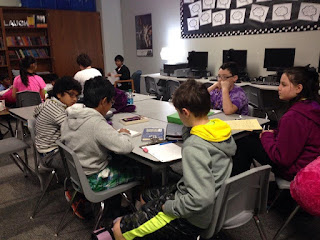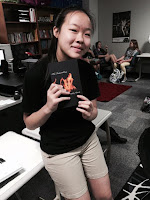 Think about your ideal lesson. Hmmm. What did it look like? Perhaps your lesson became part of your teacher portfolio and put you in the running for Teacher of the Year (TOY) on your campus.
Think about your ideal lesson. Hmmm. What did it look like? Perhaps your lesson became part of your teacher portfolio and put you in the running for Teacher of the Year (TOY) on your campus.Now think about the lesson that didn't go the way you had planned. How did you feel? Maybe you went home and ate a gallon of your favorite Ben & Jerry's or seriously considered early retirement.
Sadly, I believe teachers often feel shame when a lesson doesn't look like the polished examples on Pinterest. If you think about it, our society thrives on perfection! Student work examples in our curriculum and teacher posts on Twitter are prime examples. To up the ante, district teacher evaluation systems feed into the idea of "product over purpose."
This past summer I helped design and teach a high school summer literacy institute for bilingual newcomers. The class was part of a grant from my university called ELLevate! My co-teacher, Tricia, and I believed the idea of Heart Maps would be a fun and engaging first day lesson. The multimodal design helped level the playing field for students with limited English speaking abilities.
The first day of class, we introduced the Heart Maps by asking "What is special in your life?
Think about the people, places, and memories most important to you."
Next, examples of completed Heart Maps from past classes were shown to students as models. Instructions were clear. Crisp templates and colored pencils were sharpened and ready!
Think about the people, places, and memories most important to you."
Next, examples of completed Heart Maps from past classes were shown to students as models. Instructions were clear. Crisp templates and colored pencils were sharpened and ready!
I was surprised when the Heart Maps went unfinished the first day...
and the second day...
and the third day....
and the fourth day....
and on and on and on.
At the end of our summer institute, not ONE Heart Map had been completed!
What happened when a multimodal lesson for newcomers went unfinished?
1. Relationships were built.
Students in our class were all Latina but came from diverse backgrounds and experiences. I learned that if you were from Venezuela, you spoke a different form of Spanish than if you were from Mexico. Color coding would often be interrupted by a story or memory in a student's heart. Students were engaged in learning and listening to one another.
2. Writers blossomed.
One of the purposes of a Heart Map is to inspire writing. It's so easy to get stuck in this mindset of the "five paragraph essay" or fixated on "writing to the prompt." Instead, students are able to choose a section from their Heart Map when writing reflections.
When students are given voice and choice, writing becomes authentic and relevant to their lives.
Here are some of the examples from student writing journals:
3. Teachers and students became co-learners.
The Heart Map lesson created a space for students and teachers to become co-learners in the classroom. There is a fixed mindset in classrooms today that the teacher is in control. I've heard it called, "Sage on Stage" which is what many classrooms look like. The teacher lectures, the students take notes, all followed up by a test.
When a lesson doesn't go as planned, students have a sixth sense and can pick up on teacher insecurity or frustration. Letting go of preconceived ideas of what the lesson should look like invites innovation and creativity into the classroom.
This is when learning begins.
This is when learning begins.
My twitter post!

Confession Reflection:
- How would student learning outcomes have been different if a grade was given based on completion of the Heart Map template?
- Why is it important for campus evaluators to avoid comparisons between teachers based on student work?
- Have you ever had a lesson that didn't go as you had planned? How did you feel?







 \
\





































